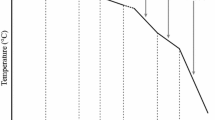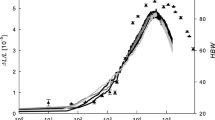Abstract
This work presents a new method of cooling curve analysis to make in situ measurements of the amount of precipitate formed in solid-state phase transformations. The presented technique is based on a first-principles analysis of thermodynamics and heat flow to develop equations that relate cooling curve data to the amount transformed. The precipitation of Ag2Al in a binary Al-Ag alloy was examined both as a practical example of this technique and to obtain metallographic measurements of the amount of precipitation for comparison purposes.






Similar content being viewed by others
References
B.T. Alexandrov and J.C. Lippold: 57th Annual Assembly of IIW, Doc number: IX-2114-04, Osaka, Japan, 2004.
H.B. Dong and J.D. Hunt: J. Therm. Anal. Calorim., 2001, vol. 64, pp. 341–50.
F. Kohler, T. Campanella, S. Nakanishi, and M. Rappaz: Acta Mater., 2008, vol. 56, pp. 1519–28.
G. Fredriksson and B. Rogberg: Metal. Sci., 1979, vol. 13, pp. 685–90.
L. Backerud, G. Chai, and J. Tamminen: Solidification Characteristics of Aluminum Alloys, vol. 2, Foundry Alloys, AFS/Skan Aluminum, Stockholm, Sweden, 1990.
K.G. Upadhya, D.M. Stefanescu, K. Lieu, and D.P. Yeager: Trans. Am. Foundrymen’s Soc., 1989, vol. 97, pp. 61–66.
E. Fras, W. Kapturkiewicz, A. Burbielko, and H.F. Lopez, Trans. Am. Foundrymen’s Soc., 1993, vol. 101, pp. 505–11.
H. Cruz, C. Gonzalez, A. Juarez, M. Herrera, and J. Juarez: J. Mater. Process. Technol., 2006, vol. 178, pp. 128–34.
M.B. Djurdjevic, W. Kasprzak, C.A. Kierkus, W.T. Kierkus, and J.H. Sokolowski: Trans. Am. Foundrymen’s Soc., 2001, vol. 108, pp. 517–28.
J.W. Gibbs and P.F. Mendez: Scr. Mater., 2008, vol. 58, pp. 699–702.
F.P. Incropera and D.B. Dewitt: Fundamentals of Heat and Mass Transfer, 6th ed., Wiley, New York, NY, 2006.
Thermo-Calc Software, SGTE SSOL2 Database, McMurray, PA, 2003.
V. Witusiewicz, U. Hecht, S. Fries, and S. Rex: J. Alloys Compd., 2004, vol. 385, pp. 133–43.
A.J. McAlister: Ag-Al Phase Diagram, Binary Alloy Phase Diagrams, 2nd ed., T.B. Massalski, ed., ASM International, 1990.
Acknowledgments
The authors would like to thank the National Science Foundation for funding through CAREER Award DMI-0547649. JWG and REH acknowledge support from the U.S. Department of Energy (contract DE-AC52-06NA25396) during manuscript preparation. The authors also would like to thank Professor Andre Costa e Silva for his help with thermophysical properties.
Author information
Authors and Affiliations
Corresponding author
Additional information
Manuscript submitted June 3, 2009.
Appendices
Appendix: Limits Of Detection
Given that conducting numerous experiments to determine the minimum quantifiable heat release is impractical; instead, the following method was devised to analytically determine what the minimum detectable limit would be. The premise of this method is to determine the amount of variation between the presented mathematical model and the actual cooling behavior of the material when no transformation is occurring then determine the minimum heat release that would be distinguishable from this unwanted variation. The amount of heat released then can be converted into a minimum detectable amount of precipitate formation.
Analysis
The variation is defined as the difference between either \( - {1 \mathord{\left/ {\vphantom {1 {g_{\text{pre}} }}} \right. \kern-\nulldelimiterspace} {g_{\text{pre}} }} \) or \( - {1 \mathord{\left/ {\vphantom {1 {g_{\text{post}} }}} \right. \kern-\nulldelimiterspace} {g_{\text{post}} }} \) and the curve to which they are fitted \( \left( {{{d\left[ {\ln \left( {T - T_{\infty } } \right)} \right]} \mathord{\left/ {\vphantom {{d\left[ {\ln \left( {T - T_{\infty } } \right)} \right]} {dt}}} \right. \kern-\nulldelimiterspace} {dt}}} \right), \) as described by Eq. [8]. The sources of variation in the single phase regions include thermocouple measurement noise or deviations in the cooling behavior from ideal convection. Because this analysis takes place solely in the single phase region, a generic g will be used in place of either g pre or g post. The variation can be described mathematically as follows:
This equation can be manipulated to obtain the following:
To convert the variation into an equivalent fraction transformed, consider Eq. [6] in the text when no transformation is occurring. Again, g pre and g post are replaced by a generic g, resulting in the following equation:
where df t is not an actual transformation but an equivalent amount of transformation attributed to variation. Replacing this equation into the numerator of Eq. [A2], the variation can be related to the heat release term C ΔH df t as follows:
Using the definitions of C ΔH and g to remove the defined terms results in the following:
This equation can be rearranged as follows:
This equation can be integrated to obtain an equation that equates the thermal event from the minimum detectable transformation to the thermal event causing the maximum variation between the fitted \( - {1 \mathord{\left/ {\vphantom {1 {g_{\text{pre}} }}} \right. \kern-\nulldelimiterspace} {g_{\text{pre}} }} \) or \( - {1 \mathord{\left/ {\vphantom {1 {g_{\text{post}} }}} \right. \kern-\nulldelimiterspace} {g_{\text{post}} }} \) and the \( {{d\left[ {\ln \left( {T - T_{\infty } } \right)} \right]} \mathord{\left/ {\vphantom {{d\left[ {\ln \left( {T - T_{\infty } } \right)} \right]} {dt}}} \right. \kern-\nulldelimiterspace} {dt}} \) data to which it is fitted.
where the limits of integration would be two time values within the single phase cooling regime that would maximize the value f t ; this would be done to represent the worst case scenario by capturing the largest variation. A factor X will be added to Eq. [A8]; this factor will be used to differentiate between variation caused by a transformation and error-related variation. This factor assumes only a transformation that is X times larger than the largest measured variation could be identified conclusively as a transformation and quantified. Adding this factor in, and pulling the constant terms out of the integral results in the following:
This equation contains constants (C p , ΔH, and T, which is the transformation temperature) as well as the arbitrary factor X, a measurable variation, and it returns a minimum detectable fraction transformed.
Results
This minimum detection limit determination method was applied to the experiments done in this study. The values used for heat capacity and heat of transformation were the same as those used in the text; the factor X was arbitrarily set to 10, and the integration of the variation was performed individually for each cooling scenario. The resulting data (Table VI) indicate that there is a large difference in the measured variation between the as-cast sample and the solutionized sample. This is because of the experimental setup used in the as-cast sample allowing for better control of the cooling environment compared with the solutionized sample, which was allowed to cool in a busy laboratory where people walking past could create air currents that negatively would affect the variation.
This effect also can be observed in the minimum detectable transformation calculations that are summarized in Table VII. These calculated values range from a fraction transformed of 1.5 wt pct Ag2Al for the well-controlled environment to slightly more than 5 wt pct Ag2Al for the worst case scenario.
Although it is difficult to extend the analysis of these experiments to other alloy systems that will transform at different temperatures and with different thermophysical properties, this analysis has shown that under well-controlled cooling conditions, small heat releases can be detected and differentiated from experimental error and quantified.
Rights and permissions
About this article
Cite this article
Gibbs, J.W., Kaufman, M.J., Hackenberg, R.E. et al. Cooling Curve Analysis to Determine Phase Fractions in Solid-State Precipitation Reactions. Metall Mater Trans A 41, 2216–2223 (2010). https://doi.org/10.1007/s11661-010-0318-z
Published:
Issue Date:
DOI: https://doi.org/10.1007/s11661-010-0318-z




